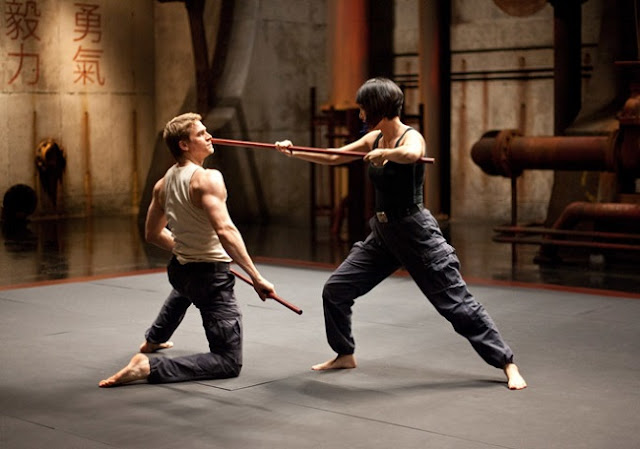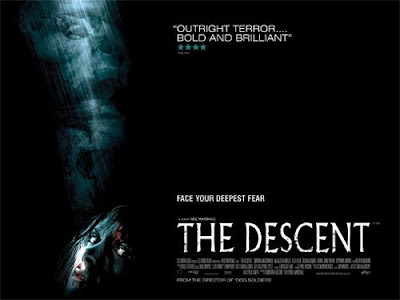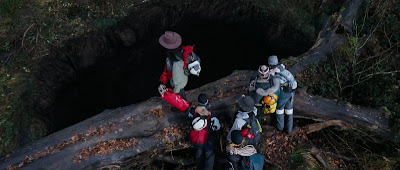 |
| Pacific Rim movie poster. |
Written by Leigh Kolb
Spoilers ahead!
The theme at the core of Pacific Rim is that collaboration and trust lead to success. And while the sweeping visuals of human-team-led robots (Jeagers) fighting with ocean monster-aliens (Kaiju) left me surprisingly entertained and satisfied, the dialogue and plot relied heavily on tired tropes.
Pacific Rim, directed and co-written by Guillermo del Toro, treads lightly around commentary on humans’ environmental abuse of Earth and allowing women in combat roles, but the bulk of the plot relies on trope after trope to support the larger-than-life action sequences between the Jaegers and Kaiju.
Overall, the film works, and it continues to get great reviews; however, it could have worked so much better had the writers tried a little harder to stay away from clichés.
The film takes place just a decade in the future, in a world that’s been rocked and partially destroyed by the Kaiju coming from the depths of the Pacific Ocean and attacking cities. The international government is halting the Jaeger program (which puts two pilots–who must share a “neural handshake” mind-meld–in the driver’s seat of an enormous robot), and the crew has one more opportunity to fight the Kaiju. Marshall Stacker Pentecost (Idris Elba) leads a crew that includes his hand-picked choice of Raleigh Becket (Charlie Hunnam) and, eventually, Mako Mori (Rinko Kikuchi).
 |
| Stacker Pentecost. |
Each of these three characters has an emotional weight–Pentecost feels protective of and responsible for Mori (he rescued and adopted her when her family was killed by the Kaiju), Becket lost his brother to the Kaiju while the two were mentally connected and fighting as co-pilots in a Jaeger, and Mori lost her family to the Kaiju when she was a little girl and has spent her life studying and training to become a pilot–and she’s “one of our brightest,” Pentecost says.
In his leadership position, however, Pentecost is concerned that Mori’s vengeance and difficult memories will impede her abilities to be a pilot, so he limits her career. Becket–who was literally in his brother’s mind when his brother was ripped from their Jaeger and brutally killed–and his memories are of no real concern to Pentecost.
 |
| Mako Mori. |
While Pentecost’s fatherly feelings of protection and concern are justifiable, Becket is forceful in his desire to have Mori as a co-pilot. Her test numbers are strong and she fights him as an equal, which none of the male candidates could. With trepidation, Pentecost allows Mori to be Becket’s co-pilot.
The larger idea that women are “too emotional” for combat positions has been pervasive throughout the debate of women serving in combat positions (which the American military officially accepted in January 2013). Mori does get caught in her memories in her first major flight simulation with Becket; however, if she’s had hands all around her wringing about that possibility, certainly her anxiety over it would have helped push her over the edge. When anyone is told, over and over again, that she is fragile and emotional–chances are, some of that will be internalized.
Pentecost angrily dismisses her after her memory drift almost causes mass destruction (in fact, she asks to be dismissed, as she “respects” Pentecost, which she tells Becket is different than being “obedient”). Becket–after seeing her memories–tells Pentecost, “You rescued her, you raised her… now you’re holding her back.”
 |
| Mori is an equal to Becket. |
Mori’s respect/obedience is troubling at times, but overall she is a strong female character. She’s excellent at what she does, and she is persistent at succeeding and meeting her goals. In fact, when Becket gets in a fight when another pilot is disrespectful to Mori, it feels odd and out of place–“nonsensical” and “unnecessary,” as Zev Chevat says at The Mary Sue. Otherwise, Becket is her greatest champion and leads with experience without being condescending.
And while the plot ebbs and flows in regard to its depiction of women (and I use that term broadly–Mori is really the only female character with lines), the film comes close to satisfying my desire for diversity and empowered female roles, but then it quickly regresses into tired tropes.
 |
| Becket is happy to see Mori is his co-pilot. |
Becket seems to be the protagonist (and I almost thought at the beginning that there would be some interesting commentary on masculinity and military culture–from the monstrous masculine robots to the fact that Becket has to work in a dangerous menial construction job before being reassigned), but Mori is more fully developed, in terms of her memories and motivations. The two share a clear bond, and whether or not it’s a romantic one depends on the viewer (del Toro wasn’t totally sure, either).
At the end (after Pentecost has figured out that they need Mori and he asks her to “protect him”), Becket and Mori travel into the depths of the Pacific to Save Humanity. Once they get there to drop the bomb, their oxygen levels plummet and Becket tells Mori to retreat into a protective pod so he can drop the bomb. “I can finish this alone,” he says, giving her his oxygen.
So he does. His motivations are pure, but it still seems like a letdown to the viewer after all that Mori has accomplished. The final blow that does, indeed, Save Humanity, is dropped by our white male protagonist (the black man has sacrificed himself, and the Asian woman is protected in a little bubble).
I would have loved to at least see Mori giving Becket CPR to save him in the aftermath (instead of him just waking up), or something to level the heroism. Her role feels diminished at the end.
 |
| Becket and Mori are both heroes, but Becket is the default protagonist. |
I don’t need a female protagonist in every film. However, when a film like this focuses on and develops the female lead without giving her the satisfaction of being a clear hero, something feels off. Either more needed to be done with Becket’s emotional baggage, or less with Mori’s. As it stands, the film perpetuated the notion that women’s emotions could be a hindrance in combat, and men’s emotions translate to strength in battle. Stuffing Mori into a pod at the climax of the film is symbolic of trying to shoo women back into their protected spaces so they don’t fly too close to the sun. I don’t think Becket as a character would have approved of that idea, nor would del Toro, probably. But that scene certainly left that taste in the viewer’s mouth–let the white guy finish the job!
I can’t stress enough how entertaining and well-done the visuals of this film are–and again, that’s coming from someone who did not expect to feel exhilarated while watching monsters fight robots. The lightly developed characters and don’t-blink-or-you’ll-miss-it female empowerment, however, left much to be desired. And while the optimistic ending and refreshing lack of American exceptionalism reinforce the idea that everyone–different ethnicities, genders, and races–needs to work together to succeed, the lackluster writing and reliance on tropes still sends the message that women’s emotions can be a hindrance and that they need to be protected.
I can’t stress enough how entertaining and well-done the visuals of this film are–and again, that’s coming from someone who did not expect to feel exhilarated while watching monsters fight robots. The lightly developed characters and don’t-blink-or-you’ll-miss-it female empowerment, however, left much to be desired. And while the optimistic ending and refreshing lack of American exceptionalism reinforce the idea that everyone–different ethnicities, genders, and races–needs to work together to succeed, the lackluster writing and reliance on tropes still sends the message that women’s emotions can be a hindrance and that they need to be protected.
Mori is instrumental in helping save the world–but she doesn’t get to set off the bomb. She’s not fully treated as a damsel in distress, but she comes too close for comfort. Maybe, just maybe, next time Becket can retreat to the pod while Mori fries the enemy.
 |
| In addition to having an almost-not-really female protagonist, Pacific Rim really only caters to the female gaze, in terms of mild sexual objectification. I guess I am simply perpetuating this. |
Leigh Kolb is a composition, literature and journalism instructor at a community college in rural Missouri.






